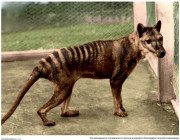Resurrecting the Dire Wolf, or Clickbait Science for the 21st Century
On the May 12th, 2025 cover of Time Magazine, you will see a picture of a white wolf below the bold word Extinct slashed through with a red…
On the May 12th, 2025 cover of Time Magazine, you will see a picture of a white wolf below the bold word Extinct slashed through with a red…
How much of our identity is shaped by genetics, and how much by society? In Where Biology Ends and Bias Begins, Shoumita Dasgupta examines how genetic science can…
New analyses from Iron Age burials reveal that women remained in their natal communities and provided the key to kinship. The findings offer essential clues about gender roles…
Decades ago, anthropologists dispelled the myth of biological race. Lagging behind in scientific understandings of human diversity, the medical profession is failing its oath to “do no harm.”…
The decades out-of-date genetics taught in most U.S. schools stokes misconceptions about race and human diversity. A biological anthropologist calls for change. ✽ On a lengthy bus ride…
A biological anthropologist reflects on how scientific research can be used to reaffirm or undermine Indigenous land ties in Argentina. ✽ In the early 1900s, two amateur archaeologists…
An evolutionary anthropologist draws lessons from paleogenetic’s journey from Jurassic Park fiction to Nobel Prize reality. ✽ The morning of my 26th birthday, I woke up to incredible…
Breakthrough treatments can now cure sickle cell anemia in the U.S. But the pricey therapies will hardly help in Nigeria, where social changes could do more for millions…
New DNA analysis has revealed surprising diversity among remains from burial sites in Peru. A genetic anthropologist explains what this suggests about the 15th century Inca palace. This…
An anthropologist explains how new forensics tools offer unprecedented answers to questions about who likely held or wore Stone Age objects. This article was originally published at The Conversation …
Paleogenomic research has expanded rapidly over the past two decades, igniting heated debates about handling human remains. Who gives consent for the ancient subjects of studies—and who should…
New evidence is prompting researchers to rethink Homo sapiens’ origin story—and what it means to be human. ✽ As a university student in the early 2010s, I recall…
An anthropologist explains the evolutionary origins of why so many people seem practically programmed to love sugar. This article was originally published at The Conversation and has been…
An archaeologist explains how studies of ancient DNA and objects reveal that expansive migrations led to much greater diversity in medieval Britain than most people imagine today. This…
An anthropologist offers possible directions for ancient DNA studies moving forward—especially regarding the field’s complex histories with Indigenous communities and public education. This article w…

Many herders, especailly in the Sub-Arctic, are threatened by the increased number of wolves, eating entire reindeer herds. In Australia they go the opposite way now: they try…

Most Carnival celebrations in Brazil have been canceled again in 2022 due to the resurgence of COVID-19, though larger cities like Rio and São Paulo are holding scaled-down…

Our recent book, Racism, Not Race, tackles a big lie: The idea that human beings have biological races. Biological races do not exist in humans. Why, then, do…

Kondoa Irangi rock art in present-day Tanzania features the cultural expressions of hunter-gatherers and pastoralists over a 2,000-year span. Nina R/Wikimedia Commons This article was ori…

Beringia National Park in present-day Russia is part of what was once a vast refuge that allowed ancestors of Native Americans to cross into North America and survive…

University of Cape Town archaeologist Simon Hall leads a visit to the farm in Sutherland, South Africa, from which the remains of several individuals were taken a century…

At the Sima de los Huesos (“Pit of the Bones”) archaeological site in Spain, researchers recovered DNA from 417,000-year-old hominin fossils that may be the ancestors of Neanderthals.…
A lot of ink has been spilled in archaeological debates about the human occupation of the continents known today as North and South America. When did people arrive?…

[no-caption] Alh1/Flickr This article was originally published at Hakai Magazine and has been republished with permission. Along the central coast of British Columbia, grizzly bears go by…